Introduction
For a format regarded as “Eternal,” the ordinary Magic player may be surprised to learn how quickly and how often the Vintage format can change. Perhaps no period better illustrates that than 2019 and 2020, in which multiple new sets have repeatedly triggered metagame convulsions, introduced new powerful decks, long-desired and status-quo upending tactics, each culminating in a wave of major restrictions, and then, most recently, the first banning in the format since 1996.
Although no cards rotate out of Vintage, the introduction of even a small number of cards can have a transformative effect. We must look no further for an illustration of this dynamic than Lurrus of the Dream-Den, a recent “companion” released in Ikoria: Lair of Behemoths. This little critter quickly upended the metagame and resulting in the first power level banning in more than 20 years. Therefore, Vintage is perhaps best understood not as a continuous format, but as an iteration of formats based upon the same principles and rule structure.
This insight struck me when I encountered a “Timeline of Standard” formats some anonymous but industrious person created on Wikipedia. What’s notable in the timeline is that the Standard formats are not simply defined by when sets rotate out, but change as each new set is added or with changes to the Standard Banned List. Therefore, each infusion of new cards – technically – creates a format different than the one that preceded it. Just scrolling through the timeline, one gets a powerful sense of this.
The same, remarkably, is true of Vintage. Each new set, each change to the Banned and Restricted List, each major rules change which alters the functionality of cards, or errata which does the same, technically changing the format. Every new card creates countless new interactions, as Lurrus illustrates. Lurrus not only makes Black Lotus much more powerful (as if that was possible), but it made permanents such as Dead Weight, Seal of Cleansing, and Seal of Fire playable, revived from the nether of the Vintage card pool.
Every new printing introduces new possibilities and strategic options within a format. When you have a format as large as Vintage, the interactions are virtually endless. A single card now has the potential to interact with the 19,965 cards in the Vintage card pool. Some of those printings, and their ensuing interactions, will be as unforeseen and powerful as Grindstone and Painter’s Servant, or Illusions of Grandeur and Donate.
Seen from this perspective, we can begin to appreciate each iteration of the format as a historical artifact, worthy of its own independent assessment and valuation. Vintage may not “rotate” as abruptly as Standard does or Extended once did, but there are moments in which the metagame that had existed is wiped away. This can happen at once, such as when a powerful new printing transforms the existing metagame or a wave of restrictions wipes the slate clean. Or it can happen gradually, through the accumulation of printings that pushes formerly dominant decks to the margins of the metagame. Either way, the Vintage format evolves, and each iteration of the format is often distinctly different in its composition and feel.
Inspired by the Timeline of Standard project, I decided to create the first-ever “Timeline of Vintage Formats.” The result is here, for players of all formats to enjoy and peruse, and I hope you do. It has many applications. Historians writing about particular rules changes or Old School retro format metagames will find this to be a handy reference, complete with citations and hyperlinks. But long time Vintage players will also find it useful for considering the macro and micro-scale changes that pushed the evolution of the format forward, and reminisce on their favorite periods in the history of the format.
Following the lead of the creators of the Standard Timeline, I provided key identifying features and notes to each iteration of Vintage. First, I indicated the dates for each format, and the specific changes that bookend each particular format. Second, I highlighted notable aspects of those changes, including key printings or landmark restrictions or unrestrictions or errata. Finally, I provided a pithy label, a descriptor to characterize that iteration of the Vintage format, and a way to remember it. If you have a better label, I will update this article with your suggestion, as this will likely be an ongoing work.
This was an enormous undertaking, but I think you’ll find it was worth it. Here are some interesting observations:
– From the release of Limited Edition through the banning of Lurrus, there are 136 iterations of the format that would become known as “Vintage,” including the two iterations that preceded the implementation of the first Banned and Restricted List announcement.
– The format currently known as Vintage has been rebranded at least three times, depending on how you count and whether you include the first two formats, as I do. Originally known as “constructed decks” with the adoption of the first mandatory Duelist Convocation Banned and Restricted List, the format was rebranded as “Type 1” on January 10, 1995, and then officially renamed “Vintage” on September 3, 2004.
– The biggest change in the format, measured by total number of new cards is the format that turns over with the simultaneous introduction of Ravnica: City of Guilds and Portal and Starter sets, due to the legalization of 6 new sets at once.
– There have been at least 4 different mulligan rules introduced since the inception the format, with the first one adopted with the updated floor rules on June 13, 1994. The changing mulligan rules have had a profound influence on the dynamics in the format, more than is generally appreciated.
Other highlights and notes are found at the bottom of the timeline. For more details on this history, including the explanations and stories behind many or all of these changes, please read the series (soon to be book) that this article accompanies, the Schools of Magic: The History of Vintage. For more on the specific reasoning behind changes to the Banned and Restricted List captured in this timeline, you may also check out this free article, “An Alternative History of the Banned and Restricted List.” It is a complete listing of every Banned and Restricted List change, along with explanations and alternative possibilities, in the first 25 years of the format.
But more than simply offer a historical record of how Vintage changed in a single timeline, I had another purpose in mind for this endeavor. I thought it might be worthwhile to use my considerable historical knowledge and first-hand experience with the format to opine on which of these formats or periods (consecutive formats) I thought was best, and which were the least compelling, fun, or interesting. With a list of formats, it is easier to compare and contrast, to remark upon those which are fondly remembered, and those which are most reviled.
This endeavor is more than a historical retrospective. What is great about the time we live in is that these formats need not be little more than historical curiosities. They can be active formats for Old School communities to enjoy. If, upon reading the timeline or this article, a group of players share a favorite period or format, I hope this article inspires them to dabble in replaying that retro format or period.
To inspire such an exploration, but also to remind readers what makes Vintage so compelling, I have curated my Top 5 “best” Vintage formats, and along with the five worst.
The Best Vintage Formats
“Best” (and “worst”) is highly subjective, and I won’t deny that my opinion and personal experience infuses both the selection of criteria and the evaluation of data and narrative that applies those criteria. For example, on August 26, 2019, Rich Shay declared that “Vintage is the worst it has ever been.” Randy Buehler chimed in, and said he agreed, and that he felt it was worse than the NecroTrix era, the Flash era, and the Academy era. For the record, the Vintage Challenge Top 8 metagame was 47% BUG variants that August, which made it one of the most dominant decks ever for a month, but I felt that the BUG deck’s dominance created interesting game play, even though the decks it was suppressing were not known for their interactivity. That period certainly wasn’t the best format ever, but I wouldn’t even rank it in the bottom five.
One of the other complicating factors is that there are formats where we have performed well individually, even though the metagame was objectively undesirable. For example, I finished 2nd place in a major Vintage tournament known as the NYSE Open V in the summer of 2017, winning an Ancestral Recall, and finished highly in a number of Vintage Challenges as well. But that summer ranks as one of the least diverse and balanced in the MTGO era of Vintage. I know others who enjoyed that metagame as well, even though it resulted in multiple restrictions.
For these reasons, I think it is important to specify one’s criteria. Just because there is subjectivity involved doesn’t mean that such an analysis is merely subjective opinion. Even for matters that are seemingly entirely subjective, such as food criticism, there are widely used objective standards: cleanliness, quality of the ingredients, originality in the recipes, politeness of the staff, etc. The same is true of Magic game play.
By wide consensus, there are objective standards about what makes a good or a bad format, even if there is a considerable degree of subjectivity in their application. Here are the criteria I explicitly considered:
Fun
Obviously, everything boils down to fun. So the question is whether I can find a way to delineate aspects of fun into a useful criteria. Therefore, let’s start over.
Diversity
In competitive Magic, “diversity” generally refers to the quantity of viable or competitive archetypes. But I mean something more than that here. I mean, yes, that there is a good range of viable and even competitive strategies. But I also mean that the strategies differ in meaningful ways from each other in appearance, tactics, colors, and strategic objectives. Diversity is the sine qua non of a healthy format, as Wizards of the Coast states on their official Rules and Formats page.
Competitive Balance
Competitive balance refers to the win rates among archetypes, or at least competitive archetypes. It doesn’t matter if there is an enormous range of competitive deck options if a single deck or two looms large over the entire format. There were many great, and even fun, versions of Vintage, where a diversity of decks existed in the metagame, but only 1 or 2 decks were likely to win a major tournament. Those have to rate lower than other formats where a wide range of decks were threats to win a tournament. There is always a best deck, but the gap between the best deck can be a chasm or a close race.
Counterplay
Counterplay is the idea that tactics and strategies can be answered by the environment, and that there are opportunities for those counter-tactics to see use. Formats in which decks were squeezed within the metagame because of inadequate counterplay don’t rank highly. Another way of thinking about counterplay is the amorphous notion of “interactivity.” Formats with counterplay appear and feel more interactive.
Cool (“Wow”) Factor
As important as the above elements are, perhaps what distinguishes Vintage most from other formats is the “wow” factor. Often, that’s just a function of the amazing and powerful cards. But it is also a function of how sweet interactions can be in a format as deep as Vintage. Therefore, it matters whether interesting things are happening, and whether those things can only occur in Vintage. The more Vintage is distinct from other formats, the more that “wow” factor comes in to play.
A Caveat or Two
Before I present my list of greatest (and worst) Vintage formats, one small note: most of these formats are bordered by, or chronologically adjacent to, versions of the format that are quite similar. To handle this, I am presenting either a single format or periods in Vintage that are adjacent but span no more than two “formats.” There is no single way to capture a period of time in the history of Vintage, just as there isn’t in geological or human chronology. However you prefer to think about the history of Vintage: as formats, periods, eras, epochs, or even eons, I encourage you to use the timeline to organize blocks of time in any way you see fit. For purposes of this article, I am sticking either to formats or periods that comprise a couple of adjacent formats.
One other problem is that just because a format was good, decent or bad at a particular time, doesn’t necessarily mean that it would be just as bad, mediocre, or good today. It is possible that, with everything the same – the same sets, the same Banned and Restricted List, the same rules, etc. – that a format that was decent in the past could be awful today. Why might this be? With the advent of Magic Online, it is easier to test ideas against high level competition. And with more than 25 years of experience, we are all presumably better deck builders than we were in the past.
So, it is possible that the format that existed “back in the day” might not be quite the same. I am evaluating formats based upon how they appeared in their original historical context, rather than trying to forecast how they might appear today. With those caveats out of the way, here we go. Here are my 5 best formats in the history of Vintage.
#5) Ice Age Era (Format # 13: Ice Age – Homelands; June 10 – October 14, 1995)
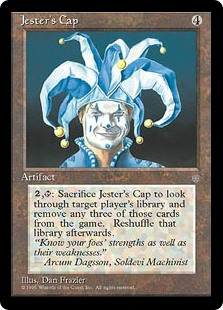 The “Type 1” format is the rebranded name for the previous format that was simply “Magic,” Constructed, when Standard (then “Type II”) was created. The Golden Age of Type 1 was the period following the restrictions of Fork and Balance until Ice Age was printed. This was the period in which The Deck emerged, and more refined and skill-based strategies were honed.
The “Type 1” format is the rebranded name for the previous format that was simply “Magic,” Constructed, when Standard (then “Type II”) was created. The Golden Age of Type 1 was the period following the restrictions of Fork and Balance until Ice Age was printed. This was the period in which The Deck emerged, and more refined and skill-based strategies were honed.
But, the truth is that the “Golden Age of Type I” is basically Old School 93/94, or what I call “Old School 94,” and the actual historical version is more imbalanced than those Old School formats. The main reason for this is that The Deck is simply dominant, and Mana Drain is unrestricted, which it is almost never is in modern Old School 93/94 retro formats. Adding Ice Age solves this problem, however, because new tools were introduced to provide counterplay and strategic competition against The Deck.
But Ice Age did more than simply balance the format, it changed the texture and feel as well. Ice Age was a mammoth set, and the first set that was introduced since Limited Edition that was intended to actually constitute Magic itself, and replace everything that came before, rather than simply an expansion set. It is deep, intricate, and richly thematic. It is fun to peruse, and the art is captivating.
Ice Age was immensely anticipated. Since there was no set between Ice Age and Fallen Empires, there was nothing to satisfy the demand for new cards for more than 6 months. Ice Age was speculated over more closely than we pour over a summer blockbuster trailer. When it arrived, there was a pent-up and insatiable need to try out new tools and tactics, and Ice Age more than met this need.
But above all, it transformed the strategic possibilities in the format. The most important printing at the time it was released was believed to be Jester’s Cap, since it directly attacked The Deck. Over the next year the most important printing proved to be Necropotence, anchoring a new class of strategies. But in the immediate aftermath of its release, many new strategies were possible or deepened, including Reanimator, Draw 7 Recursion combo, Land Tax/Edge combo, and much more. The strategic possibilities opened by Ice Age were the bloom of a frozen rose. With the advent of cantrips our fundamental understanding of the game began to evolve.
Reanimator gained, among other cards, Ashen Ghoul, Dance of the Dead, and Demonic Consultation. Combo decks gained with Forgotten Lore, which could be used to replay restricted cards. And Land Tax/Edge gained both Brainstorm and Zuran Orb.
This format is not perfectly balanced, but it is meaningfully diverse, fun, and fascinating to watch and experience. That’s why it ranks number 5 on my list.
#4) Calm Before Khans (Formats # 101-102: Conspiracy – Khans of Tarkir; June 6 – September 25, 2014)
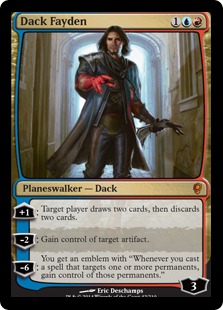 Worldwake was the beginning of a long fallow period in Vintage play, largely due to the oppression of Lodestone Golem. The first thing that finally began to change that was the printing of Dack Fayden in Conspiracy. It fundamentally opened up the format again, by rebalancing the metagame with another strong tool against Workshop decks, so that Dredge, Oath, Delver, Dark Petition Storm, and many other decks were viable.
Worldwake was the beginning of a long fallow period in Vintage play, largely due to the oppression of Lodestone Golem. The first thing that finally began to change that was the printing of Dack Fayden in Conspiracy. It fundamentally opened up the format again, by rebalancing the metagame with another strong tool against Workshop decks, so that Dredge, Oath, Delver, Dark Petition Storm, and many other decks were viable.
This was a format of new concepts, old concepts, and a format that had been out of balance quite carefully recalibrated into a broadly diverse balance. Pretty much everything and anything was playable. Propitiously, it was also the Vintage format at the moment that Vintage finally arrived on Magic Online. The only “premier” event to fire during this period on that platform provides a good taste of what this format was like. And the first part of the first season of the Vintage Super League aired most of the season during this period, showcasing a beautiful format.
Of course, the party would soon end. Khans of Tarkir arrived and obliterated this delicate format with the printing of Treasure Cruise and Dig Through Time. And what followed with Monastery Mentor was even worse.
#3) The Most Diverse Vintage Format Ever?/Dredge Emerges (Formats # 59-60 Ravnica: City of Guilds/Portal/Starter – Time Vault Errata; October 20 – April 20, 2006)
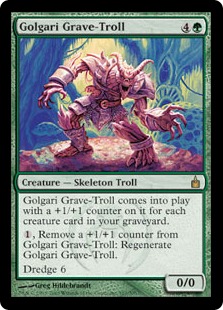 What defined this era were three converging events, all occurring a few months before: the release of Ravnica: City of Guilds, the legalization of Portal sets into Eternal formats, and the restriction of Imperial Seal and Personal Tutor. These events created massive new opportunities for deck construction. Among them were the emergence of Dredge as a powered up Reanimator archetype, and “Grim Long,” the new iteration of the Dark Ritual combo deck, using Starter 1999’s Grim Tutor. Both of these decks are special to me personally, as I was the first person in Vintage to Top 8 a major tournament with each of the new archetypes.
What defined this era were three converging events, all occurring a few months before: the release of Ravnica: City of Guilds, the legalization of Portal sets into Eternal formats, and the restriction of Imperial Seal and Personal Tutor. These events created massive new opportunities for deck construction. Among them were the emergence of Dredge as a powered up Reanimator archetype, and “Grim Long,” the new iteration of the Dark Ritual combo deck, using Starter 1999’s Grim Tutor. Both of these decks are special to me personally, as I was the first person in Vintage to Top 8 a major tournament with each of the new archetypes.
Although Dredge decks had technically been possible, it wasn’t until this period that they became sophisticated enough to compete with the big boys of Vintage. Thus, this was the period in which Dredge emerged as a metagame player, along with a newly powered up Dark Ritual combo deck.
But these decks added to an already crowded Vintage metagame space: Stax, Control Slaver, Gifts Control, Oath, and many more were all major players. There may be no single period in the entire history of the format were there were so many competitive options, not just viable deck options. And with nothing so powerful that it couldn’t be fought. It was probably the most diverse and balanced iteration of Vintage ever.
Within this period, Guildpact was a relatively minor set in the grand scheme of things, but it did one very important thing: it introduced Leylines to Magic.
When I think of what a great Vintage format should aspire to be, this is the format that I often have in mind. This is a realistic version to aspire toward. And it was enormous fun. It was, not incidentally, the height of the StarCityGames Power Nine circuit as well.
#2) The Storm Before the Tezzeret (Format #73: Eventide – Shards of Alara; Time Vault Errata; B&R Update; July 25 – October 1, 2008)
 The year from the summer of 2007 to the summer of 2008 is hard to describe. It was like an aberration from the larger trajectory and evolution of the format, on account of the unrestriction, and the re-restriction of Gush. But what followed it was incredible.
The year from the summer of 2007 to the summer of 2008 is hard to describe. It was like an aberration from the larger trajectory and evolution of the format, on account of the unrestriction, and the re-restriction of Gush. But what followed it was incredible.
The restriction of Flash, Ponder, Merchant Scroll, Brainstorm and Gush in June 2008 was overkill, but it created space for a beautiful moment in Vintage. In the clearing, two decks briefly bloomed: a powered-down version of The Perfect Storm, using Grim Tutor in the place of what is now filled by Dark Petition, and a Control Slaver deck utilizing Strategic Planning. These two decks were the entirety of the Top 4 decks at the 2008 Vintage Championship, and TPS won a smattering of tournaments before and after.
But what made it beautiful was that pretty much everything else was viable: Stax, Dredge, Painter Servant combo, Dredge and others were all viable and competing in a beautiful garden. But this cornucopia of Vintage goodness was short lived.
It came to crashing halt in the fall when Shards of Alara arrived. Shards not only gave us nasty cards like Ad Nauseam and Tezzeret the Seeker, but more importantly, it also coincided with the removal of power-level errata and an adjusted templating for Time Vault. Predictably, the format collapsed into a miasma of Time Vault Tezzeret control, leading to the restriction of Thirst for Knowledge a few months later. Had Tezzeret not been printed, the errata on Time Vault would not have been quite so format-warping. But with both changes at the same time, the format sunk into a deep funk for a while.
#1) The Last Dance (Before Fetchlands) (Format # 46: Judgment – Onslaught; July 1 – October 31, 2002)
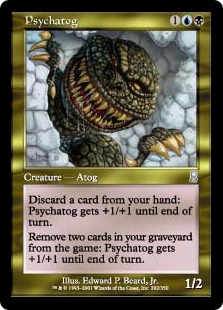 The greatest version of Vintage of all time, this was a truly fantastic format. It was so great it is difficult to know where to begin. So let me begin by setting the stage. In late 2000, Necropotence was restricted, and the format became essentially 5c Control decks versus Aggro strategies. The printing of Fact or Fiction changed that dynamic, and Accelerated Blue decks, using 4 Fact or Fiction, quickly rose to the top and dominated the format all year. Finally, at year’s end, Fact or Fiction was restricted.
The greatest version of Vintage of all time, this was a truly fantastic format. It was so great it is difficult to know where to begin. So let me begin by setting the stage. In late 2000, Necropotence was restricted, and the format became essentially 5c Control decks versus Aggro strategies. The printing of Fact or Fiction changed that dynamic, and Accelerated Blue decks, using 4 Fact or Fiction, quickly rose to the top and dominated the format all year. Finally, at year’s end, Fact or Fiction was restricted.
Rather than rewind the format back to its previous iteration, the format actually evolved along a completely different trajectory due to a convergence of forces. First of all, errata on Illusionary Mask in 2001 eventually led players to the recognition that Phyrexian Dreadnaught could be “cheated” into play with Mask. This created a powerful new, and very exciting deck: MaskNaught. Secondly, with Fact or Fiction restricted, mono blue decks began pairing Back to Basics and Ophidian with tremendous effect. This was very difficult for the multicolor control decks (Keeper) to defeat.
Third, Odyssey had just been printed. Odyssey introduced an incredible new finisher that would soon trump Morphling as the preferred victory condition for blue-black control decks, in Psychatog! Fourth, Judgment was most recently printed, and this introduced a number of important cards, including Worldgorger Dragon. With Compulsion from Torment and Bazaar of Baghdad, Worldgorger Dragon could be used with an Animate Dead effect to create an infinite loop that could draw the entire library and create infinite mana.
Fifth, Patrick Chapin, who long favored Academy combo decks (basically the Restricted List), began playing Miracle Grow in Type 1 that summer, and even won the de facto Type 1 Championship that summer at GenCon. This would bring Gush to the fore, while Psychatog would bring the Intuition/Accumulated Knowledge draw engine to fore as well. And finally, Workshop decks, like Stacker 2 (Mono Red Workshop Aggro/Prison) and Tools ‘N’ Tubbies (Workshop Aggro with Survival of the Fittest, and Goblin Welder’s, by Judgment’s Incarnation cycle) had fully bloomed, with Stax about to emerge around the corner, as a predator to Grow.
I should also mention that Judgment gave the format Cabal Therapy, which was unbelievable with Academy Rector, but there was not yet a simple win condition for this absurd combo because Scourge (and the storm mechanic with it) had not yet seen print. So it wasn’t until a year later that Rector Tendrils became a deck – and a powerful one at that.
Most importantly, this all occurred before Onslaught arrived. It may be difficult for newer players to appreciate the change wrought by Onslaught, but it was transformative. Before Onslaught, mana base construction was a more tenuous endeavor, and much more forethought and consideration was required. City of Brass anchored control decks, while City and Gemstone Mine also anchored combo decks. Blood Moon and Back to Basics were format-wide menaces, and there was a real cost to playing a fifth, fourth, or even a third color. Two color decks often used pain lands from Ice Age or Apocalypse. Onslaught changed all of that in a heartbeat, and also made Brainstorm ubiquitous in the process. The format changed almost overnight.
The Brainstorm/Fetchland engine power up Psychatog beyond measure. But before then, Chapin was using Brainstorm with Land Grants for a similar effect. The metagame was basically Chapin evangelizing Grow, a few players still playing Academy combo, a good deal playing Keeper, a smattering of players playing MaskNaught with great success, Stacker and TnT, Mono Blue, Sapphire Oath, and the newly emergent Worldgorger Dragon combo deck, with its incredible card advantage engine (ue to the combination of Bazaar and/or Compulsion alongside four copies of Squee, Goblin Nabob).
In short, it was, or nearly was, the greatest metagame in the history of the format. Around this time for the next year or so, I used to carry a small box with four decks (no proxies except for duplicate power): a Workshop deck (first TnT, then Stax), a Gush deck (first Miracle Grow, then Psychatog), Worldgorger Dragon Combo, and MaskNaught. Anywhere I went, players would more than happy to battle with any two of those decks, and the game play was simply amazing. Everyone I introduced to these decks was instantly hooked on the format. I was able to use these decks to recruit lots of new players to build local Type 1 tournaments in my local store, or side events at larger events, like PTQs or Grand Prix.
With Onslaught, this beautiful era closed in the fall, because Psychatog moved to the head of the pack (now called GroAtog). Workshop Prison rose to face it, and Dragon combo and Rector Tendrils soon emerged as well. Burning Wish + Lion’s Eye Diamond (for Yawgmoth’s Will) was in this format, but without storm cards, which came with Scourge in June of 2003, there was no straightforward and dominate way to abuse this combo.
Therefore, this really was the true golden age of the format. The format just before everything became so much more intense. MaskNaught was an absurdity in this environment, but was soon not close to good enough, and disappeared.
The period from the restriction of Fact or Fiction until Onslaught (cover, technically speaking, three iterations of the format), more broadly, is probably the single greatest period in the history of the format. It was a peak from which the format has approached but never eclipsed.
The Worst Vintage Formats
One undeniable feature of the Magic community is that we are a bunch of complainers. We love to complain about everything: set design (“there are too many new playables and my format isn’t recognizable!” or ”This set sucks; there aren’t enough playables!”), the artwork and card design, and, yes, the management of formats.
There are many candidates for “worst format of all time,” perhaps many more than “best format,” but the most obvious place to look are at the periods of time that resulted in the most restrictions. The problem is that restrictions targeting the same set of problems in a format come in two basic varieties: those that resulted in a cluster of simultaneous restrictions, or those that came in waves over time. Some, like the restrictions that flowed through Urza block, came in both forms. But those that resulted from the dominance of Workshop Aggro and Turbo Xerox strategies followed Khans of Tarkir came largely in waves, resulting in 8 restrictions over a two and half year period addressing the same persistent underlying problems.
#5) Trinisphere’s Last Stand (Format # 56: Betrayers of Kamigawa – B&R Update; February 20 – March 19, 2005)
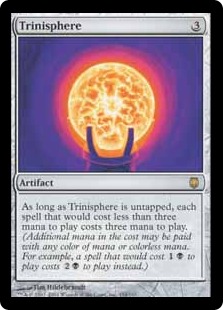 Trinisphere was unrestricted from February 20, 2004 until March 19, 2005, for a total of 13 months. Remarkably, that only spans 4 iterations of the format, broken up by the releases of Fifth Dawn, Champions of Kamigawa, and Betrayers of Kamigawa. Although Trinisphere was truly miserable, when I look back at the evolving metagame, Top 8 decklists, breakout decks, and emergent strategies, I find that the format actually appeared pretty healthy from a bird’s eye view. In the immediate aftermath of Trinisphere’s printing we saw Goblins winning a 200+ player tournament. It turned out that Goblin Lackey and Aether Vial were pretty good against Trinisphere decks.
Trinisphere was unrestricted from February 20, 2004 until March 19, 2005, for a total of 13 months. Remarkably, that only spans 4 iterations of the format, broken up by the releases of Fifth Dawn, Champions of Kamigawa, and Betrayers of Kamigawa. Although Trinisphere was truly miserable, when I look back at the evolving metagame, Top 8 decklists, breakout decks, and emergent strategies, I find that the format actually appeared pretty healthy from a bird’s eye view. In the immediate aftermath of Trinisphere’s printing we saw Goblins winning a 200+ player tournament. It turned out that Goblin Lackey and Aether Vial were pretty good against Trinisphere decks.
Not only was the metagame interesting, but new decks were constantly emerging (like UR Fish and Oath with Orchard and Doomsday, which was unrestricted when Champions was released). The format was dynamic and Top 8s were quite interesting. Even the Vintage Championship, which had 4 very different Trinisphere decks in the Top 8, the winning deck was Control Slaver in a Top 8, which also saw Mono Blue Control (piloted by yours truly), a 5c Belcher player, and a Fish deck.
It really wasn’t until the final months that things turned south, as you can see from this metagame report, where Trinisphere decks rose to more than 26% of Top 8s. Trinisphere wasn’t always dominant, but it was usually oppressive. The restriction of Trinisphere was based upon the ultimately undeniable reality that something needed to be done about it.
Trinisphere itself was probably the single most unhealthy card ever printed since Alpha, in terms of Vintage play. A first turn Trinisphere was about the most unfun thing that could happen to you, and there was very little you could do about it. You had essentially three options: 1) Force of Will it, 2) Wasteland your opponent’s Workshop to try to break symmetry, 3) or play your own Workshop. None of these options were very attractive. This format was miserable, even if the strategic breadth wasn’t as bad as the game play.
#4) Hangarback Shops Arrive (Format # 107: Magic Origins – Battle for Zendikar; B&R Update; July 17 – October 1, 2015)
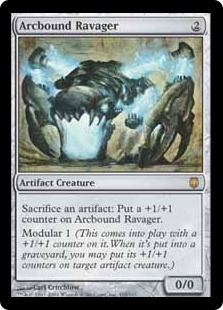 With few exceptions, the epoch from Worldwake (February 2010) through December of 2018 was a bad period in Vintage by most objective or subjective criteria. The main reason for this has been the incredible sustained dominance of Workshop Aggro strategies in the format, primarily bolstered by Lodestone Golem, until its restriction in 2017, but even beyond that point, up through the 2017 North American Vintage Championship, which infamously had a Top 8 entirely composed of 5 Workshop decks and 3 Oath decks.
With few exceptions, the epoch from Worldwake (February 2010) through December of 2018 was a bad period in Vintage by most objective or subjective criteria. The main reason for this has been the incredible sustained dominance of Workshop Aggro strategies in the format, primarily bolstered by Lodestone Golem, until its restriction in 2017, but even beyond that point, up through the 2017 North American Vintage Championship, which infamously had a Top 8 entirely composed of 5 Workshop decks and 3 Oath decks.
In fact, Workshop Aggro’s peak is probably the 2017 Vintage Championship, going low to the ground with Foundry Inspector and Steel Overseer, as well as Walking Ballista. At the time, I asked Andy Markiton, the format champion, if his deck was the best Workshop Aggro deck of all time, and he answered in the affirmative. It was only the emergence of Paradoxical Outcome that began to break Workshop Aggro’s stranglehold on the environment, as well as a load of restrictions.
That period is a close candidate for the one of the worst periods in Vintage history, but during that entire period, probably the absolute nadir – even worse than the summer or fall of 2017 – was the summer of 2015. With Magic Origins, Hangarback Walker gave the Workshop Aggro deck yet another incredibly powerful weapon, and it made the Ravager combo even more lethal. In an instant, the Workshop Aggro deck could create enough damage to kill an opponent with a Ravager and a Triskelion, thanks to Hangarback as additional fuel. This made Workshop Aggro a combo deck as much as an Aggro deck, in a similar vein to how Psychatog decks used Berserk a decade earlier.
This led to extreme discontentment, resulting in the restriction of Chalice of the Void, and eventually Lodestone Golem and Thorn of Amethyst. It is hard to overstate how absurd Golem was, especially with Chalice. It was similar in power to Trinisphere, but with a 4 turn clock built in. This was a truly awful period, and it led to tactics like Ingot Chewer being widely adopted as the most played creature in the format for years, and one of the few answers that could cut through Chalice and Thorn, even if it still cost 2 to kill a Golem.
What a miserable time!
#3) Flash Spooks Vintage (Format # 70: Morningtide – Shadowmoor; February 1 – May 1, 2008)
 There have been some truly broken and dastardly decks in the history of the format, but perhaps none is as obviously broken as the Flash combo. The combo was so absurd because it only required two mana: one colorless and blue to literally win the game. And, the deck was so resilient because it played cards like Force of Will, Duress, and Misdirection, as well as Merchant Scroll, Brainstorm, and Summoner’s Pact (to find the Protean Hulk). In short, it had a compact combo, a light mana base, tutors for both combo parts, and an enormous amount of disruption to shield the combo or disrupt an opposing strategy.
There have been some truly broken and dastardly decks in the history of the format, but perhaps none is as obviously broken as the Flash combo. The combo was so absurd because it only required two mana: one colorless and blue to literally win the game. And, the deck was so resilient because it played cards like Force of Will, Duress, and Misdirection, as well as Merchant Scroll, Brainstorm, and Summoner’s Pact (to find the Protean Hulk). In short, it had a compact combo, a light mana base, tutors for both combo parts, and an enormous amount of disruption to shield the combo or disrupt an opposing strategy.
The combo was already widely despised when Morningtide was released, bringing with it a massive upgrade through an unusual white creature, Reveillark. This allowed the combo to win at instant speed, and thereby use Pact of Negation essentially as another Force of Will!
The only reason it did not dominate the entire format was because Leyline of the Void was the second most played card in the format (after Force of Will, of course), and that essentially made Flash-Hulk a three-card combo. That’s why it only peaked at 13.24% of Top 8s in this period. The most broken deck ever was stymied by the power of the disruption in the format. That’s what’s truly remarkable about Vintage.
Yet the combo was so absurd that when Shadowmoor was released in May, Painter’s Servant combo immediately vaulted to the top tier because you could use Pyroblast and Red Elemental Blast main deck to help combat Flash (among a sea of other blue strategies)!
This was perhaps the best example of a metagame that was diverse, but not healthy. Flash was a part of that story. And it was so broken that this period ended with 5 restrictions, four of which were in the Flash deck: Flash, Brainstorm, Merchant Scroll, and Ponder. I believe that the deck would have been seriously hampered if they had just restricted any two of those cards. It was nonetheless not a pretty period, although it is noteworthy.
#2) Type 1 is Broken: Combo Rising / Combo Winter (Format # 28-30: Urza’s Saga – B&R Update; November 1, 1998 – April 1, 2000)
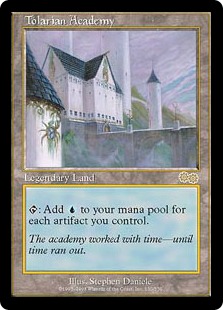 Urza’s Saga dropped into the Type I format like a thunderclap. In his set review, Zvi Mowshwitz wrote:
Urza’s Saga dropped into the Type I format like a thunderclap. In his set review, Zvi Mowshwitz wrote:
“Unlike the past few sets, whose impact on Classic has been small (except for the brief time when you could have 4 of Wasteland and Strip Mine), Urza’s Saga’s impact looks to be huge. If Type I is to survive as a playable format…several cards in the set will have to be restricted. In fact, at least one of them was so obviously a problem card that it should have been put on the Restricted List before it was even printed.”
Tolarian Academy was the main problem, in a format defined by Moxen. But other new additions included Yawgmoth’s Will, Time Spiral, and Windfall. Tolarian Academy might not have been nearly so problematic had Mana Crypt, Mana Vault, Lotus Petal, and Mox Diamond not all been legal and unrestricted in Vintage. In addition, Vampiric Tutor and Mystical Tutor were also unrestricted. It was trivially easy to cast a first turn Windfall, Wheel of Fortune, Timewister, or even Time Spiral, and then continue to combo out. Prosperity was also an option.
The only awkward thing about the deck was that it lacked an elegant and combat win condition like Tendrils of Agony. Instead, it had to use the combo of Capsize + Fastbond + Stroke of Genius or, after Urza’s Legacy was released, could use Grim Monolith + Power Artifact for infinite mana.
Had most or many of these cards been restricted, then the format might not have been nearly so stupid. But it was truly awful. The restrictions in January of Tolarian Academy, Windfall, and Stroke of Genius (the win condition) were not enough. Not because restriction didn’t work, but because Urza’s Legacy and Urza’s Destiny introduced more absurd cards like Yawgmoth’s Bargain, Tinker, and Memory Jar. The Restricted List just couldn’t keep up with powerful new printings.
Perhaps the most notorious period in the history of the game, the Vintage format stunk from Urza’s Saga until the mass restrictions of October 1, 1999, in which 18 cards were restricted – the same number restricted at the inception of the format! But the worst period, by a hair, was the first two months when Academy itself was unrestricted.
#1) Trix Dominant (Format # 37: Prophecy – B&R Update; July 1 – September 30, 2000)
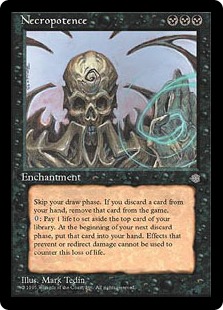 Just when the dust had settled on the Academy era, players hoped for a return to normalcy – where decks like Keeper and burn-based Aggro decks would once again rise to the fore. Instead what happened was that an even more dominant combo deck arose. Of the 16 players who competed in Kuala Lumpur in March, 2000, 9 of them played Necropotence, and 6 of them played Necro-Donate (Trix), which used the Illusions of Grandeur and Donate combo to win the game.
Just when the dust had settled on the Academy era, players hoped for a return to normalcy – where decks like Keeper and burn-based Aggro decks would once again rise to the fore. Instead what happened was that an even more dominant combo deck arose. Of the 16 players who competed in Kuala Lumpur in March, 2000, 9 of them played Necropotence, and 6 of them played Necro-Donate (Trix), which used the Illusions of Grandeur and Donate combo to win the game.
This actually understates the dominance of NecroTrix. One of the largest regular Type I tournaments of the era was the Dülmen, a monthly event in Germany. This event regularly got more than 60 players, and often more than 100 per month. The first reported result we have from June was won by Trix. The 2nd and 3rd place decks were also Necro decks, although like the other three players in the March 2000 Invitational, playing either decks with pump Knights and Juzams, or Drain Life effects like Corrupt, or Mirror Universe. Either way, Necropotence was dominant.
I suppose it is possible that even a field dominated by a single deck or engine can be fun if the game play is interesting enough. Not every mirror match is a crap shoot. But this was a format that not only had essentially one viable tactic (Necro) and terrible game play, the mirrors were miserable. You either had Force of Will for Necro, or you lost. And the games ended in miserable fashion, with players using Pyroblast to both destroy their own Illusions (after it had been donated), or even more miserably, using it on an opponent’s Illusions’ Comes Into Play trigger, so that the player lost life before gaining it. And Pyroblast couldn’t do anything about Necropotence itself. This was misery at its finest, and was the worst Vintage format of all time.
Thanks for reading my top 5 best and worst. Take a moment to peruse the format list one more time. I’d love to hear your thoughts on the best and worst formats in Vintage history. Agree or disagree, I’d like to read your best and/or worst formats, periods, or eras, using the hashtag #VintageTimeline.
Until next time,
Stephen Menendian

